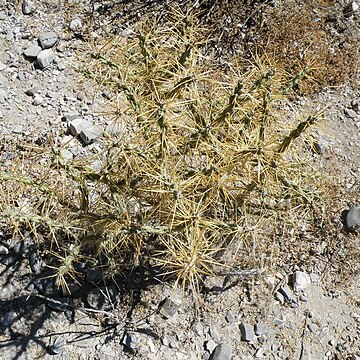Erect open, spreading, untidy shrub 0.5–2.5 m high, to 4 m diam., large plants forming a central stem. Stem segments alternate or opposite, narrow-subcylindric, 4–26 cm long, 6–12 mm diam., tuberculate, glabrous, green to grey-green, often reddish, terminal segments readily detached; tubercles few, elongate, abruptly tapered at apex, 12–25 mm long, 3–4.5 mm wide, projecting 3.5–4.5 mm. Areoles apical on tubercles, subcircular to obovate, flattened, filled with white wool and glochids, aging grey to black, usually 6–12 mm apart. Leaves succulent, terete, tapering to a point, 6.5–9 mm long (to 16.5 mm long in U.S.A.). Spines rarely absent or 1 or 2 (–4) per areole, at most areoles, straight to slightly arched, commonly deflexed, not obscuring stem, usually 1 long patent or slightly deflexed, the longer spines 20–45 mm long, 0.5–0.75 mm wide at base, and occasionally with 2 small, weak, deciduous spines around the base of the larger spine, white to pale brown; spine sheaths tightly fitting, tan. Glochids in a dense adaxial tuft, 0.5–3 mm long, reddish tan to brown. Flowers 30–50 mm diam.; outer tepals succulent, greenish pink or brownish pink, the margins reddish or reddish brown, 5–12 mm long, 5–10 mm wide; inner tepals reddish to magenta, greenish to reddish bronze at base, obovate-cuneate to spathulate, 12–20 mm long, 6–9 mm wide, the apex acute or truncate with a short mucro. Staminal filaments pale pink above, creamish below, anthers pale yellow to white. Style pale pink to purple-pink; stigma lobes white to pale yellow. Pericarpel tuberculate, spineless at anthesis. Fruit solitary or proliferating and forming chains up to 3 or 4 links long, obovoid, the umbilicus shallow, 15–50 mm long, 12–20 mm diam., low tuberculate, spineless or a few weak and deciduous spines present on distal areoles, fleshy at maturity but only slightly juicy, yellowish orange to brownish orange at maturity, indehiscent. Seeds ovoid, flattened or angled, 3–5 mm long, 3–4.5 mm wide.
More
Shrubs scraggly, openly branched, 0.5-2.5 m. Stem segments usually alternate, green, 4-20 × 0.6-1.2 cm; tubercles obvious, 1-2.5 cm; areoles subcircular to oval, 2.5-3.5 × 2-3 mm; wool yellow, aging gray to black. Spines (0-)1-2(-4) per areole, at most areoles, straight to slightly arched, commonly deflexed, not obscuring stem, yellow to gray, tipped yellow, acicular, the longest 1-3 cm. Glochids in adaxial tuft, yellow, 0.5-2.5 mm. Flowers: inner tepals greenish basally to reddish bronze, tinged magenta apically, spatulate-apiculate, 15-25 mm; filaments greenish basally to bronze distally; anthers yellow; style greenish bronze; stigma lobes cream. Fruits green becoming red, obovoid to cylindric, 13-34 × 10-20 mm, fleshy, low tuberculate to smooth, spineless; tubercles subequal; umbilicus 3-6 mm deep; areoles 16-28. Seeds tan, squarish to oval, 4-5 × 3.5-4 mm, warped, sides smooth to lumpy; girdle broad, low-ridged. 2n = 44.


